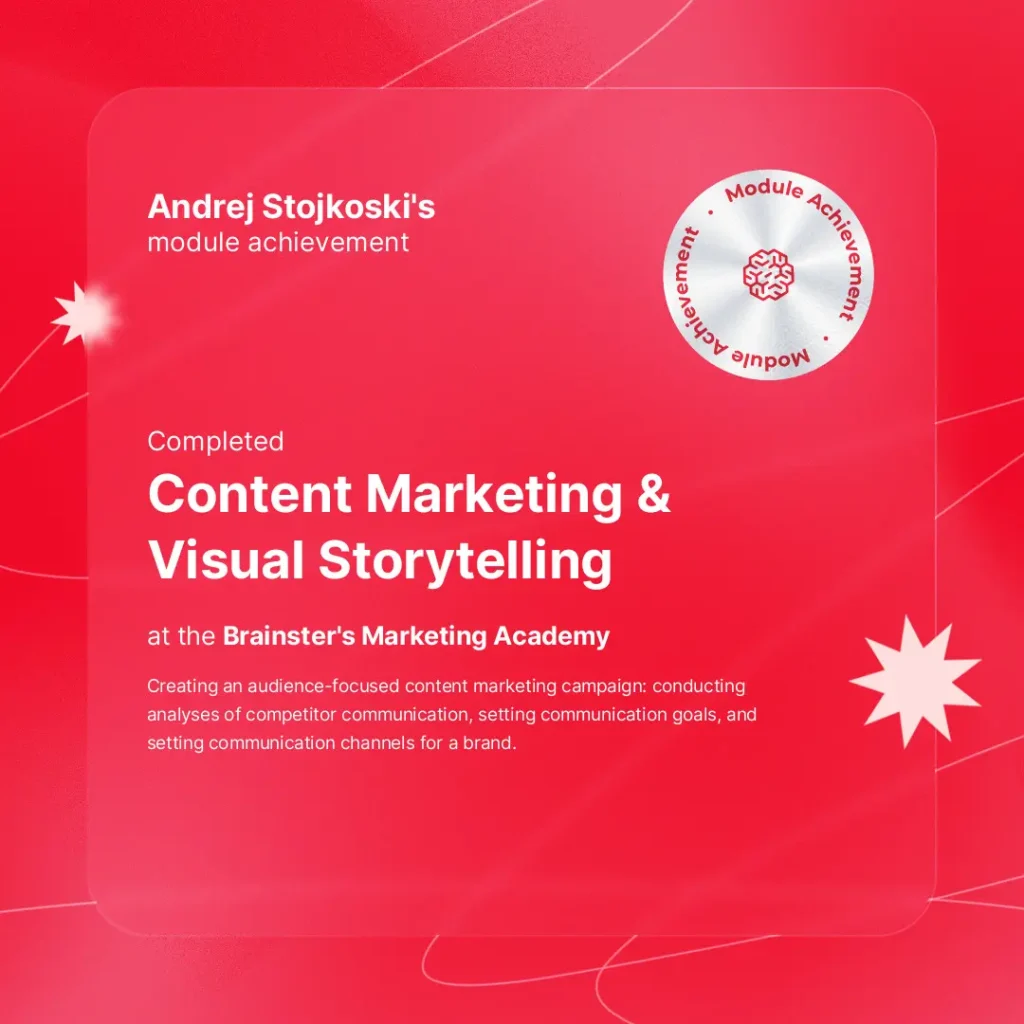Evolving into Content Marketing & Visual Storytelling.
Fresh off the Email Marketing and Automation module, where I built automated flows and learned to nurture leads effectively, I stepped into a new but connected challenge—Content Marketing & Visual Storytelling.
If email campaigns help maintain relationships, content marketing is how those relationships begin. Over two creative and research-intensive weeks, this module at Brainster’s Digital Marketing Academy taught me how to craft compelling brand narratives and strategic campaigns that resonate deeply with target audiences.
My Expectations for the Content Marketing & Visual Storytelling Module
Coming in, I expected to learn how brands create consistent content that informs, inspires, and converts. I was especially eager to explore the strategic side of content marketing—beyond just writing posts. My goal was to understand what makes content effective, how to identify the right channels, and how visual storytelling plays a role in audience engagement.
I also hoped this module would bridge the gap between automated email content (covered previously) and long-term brand storytelling. And it did exactly that.

What I Learned in the Content Marketing & Visual Storytelling Module
This module was broken into two key phases—each building a crucial part of a complete content marketing strategy.
🔹 Week 1: Foundations of Content Strategy
We kicked off with the “why” behind content marketing—what it is, why it matters, and how it differs from direct promotion.
Here’s what I learned:
- Content Marketing vs. Promotional Messaging: Content isn’t about selling—it’s about serving.
- Internal Analysis: Reviewing a brand’s existing communication (or lack thereof) and identifying gaps.
- Competitor Research: Analyzing competitors’ tone of voice, posting frequency, visual identity, and engagement strategies.
- Persona Development: Creating detailed audience personas to tailor messaging.
- Communication Goals: Setting realistic, audience-driven content goals.
- Channel Selection: Choosing where and how to reach the audience—social media, blogs, video, etc.
This phase culminated in building the first half of a content strategy for a sample brand, focusing on research, analysis, persona-building, and channel planning.
🔹 Week 2: Bringing It to Life with Tone and Visuals
Once we had the strategy down, it was time to shape the voice and visuals.
Key concepts included:
- Tone of Voice: Creating a brand personality that feels human, trustworthy, and consistent.
- Visual Storytelling: Using graphics, video, and design to connect emotionally.
- Yearly & Monthly Content Calendars: Planning long-term strategies that remain agile and audience-centric.
- Content Evaluation: Reviewing the effectiveness of current brand communication and proposing improvements.
We wrapped up this module by completing the second phase of the strategy project: a fully developed tone of voice guide, visual identity concepts, and a timeline for rolling out quality content.
How I Applied the Content Marketing Module in Practice
Much like previous modules, this one wasn’t just theory—it was hands-on and collaborative. We worked in small teams to build a two-phase content marketing strategy for a selected brand.
Here’s how I applied the learning:
- Conducted a full internal and external analysis for a brand, identifying missed opportunities in their tone and visuals.
- Developed a persona-driven strategy, mapping content formats to each audience segment.
- Created a visual tone board, exploring colors, fonts, and imagery styles aligned with brand values.
- Planned out a 12-month content timeline, with a focus on consistency and scalability.’
This practical approach allowed me to combine analytical thinking with creativity—skills that are essential in content-driven roles today.
My Experience with the Module
This was one of the most engaging modules for me because it was all about storytelling—but with a strategic lens.
I enjoyed diving deep into persona building and aligning content goals with both audience needs and brand values. Collaborating on tone of voice and visual identity helped me appreciate how every piece of content tells a story, whether it’s a blog post, Instagram Reel, or a 15-second YouTube ad.
The module also gave me confidence in evaluating content—not just creating it. I can now assess whether communication truly meets user needs and drives engagement.
Tools and Concepts I Worked With
Tool/Concept | Purpose |
Content Marketing Strategy | Structured content development plan |
Persona Building | Understanding and segmenting audience types |
Tone of Voice Framework | Developing a consistent brand personality |
Visual Storytelling | Engaging audiences with impactful design |
Content Calendar | Planning long-term publishing strategy |
Channel Analysis | Choosing the best platforms for distribution |
Top Skills I Gained from the Module
✅ Content Strategy Development
Building campaigns around goals, personas, and audience needs.
✅ Audience-First Planning
Understanding what users want—and crafting content to meet those needs.
✅ Visual Branding
- Designing content that is visually aligned with tone and message.
✅ Strategic Analysis
- Evaluating competitors and improving brand communication quality.
✅ Long-Term Campaign Structuring
- Creating monthly and yearly timelines to support consistent content publishing.
Why Content Marketing & Visual Storytelling Are Essential Today
Consumers are bombarded with content daily—but what stands out is storytelling with heart and strategy.
That’s what this module taught me: content isn’t just content—it’s a conversation. And every visual, word, and channel needs to align with the brand’s message and the audience’s needs.
When content is backed by research, grounded in audience psychology, and delivered through the right visuals, it becomes magnetic.
Final Thoughts: Crafting Content That Connects
The Content Marketing & Visual Storytelling module was the perfect follow-up to Email Marketing and Automation, giving me a broader lens on how content engages, informs, and ultimately converts audiences.
It also sharpened my skills in strategy, design, and communication, empowering me to not just write content—but to plan, design, and measure it strategically.
This experience gave me the confidence to create content plans that are not only beautiful and engaging but also purposeful and data-informed.